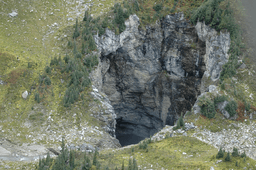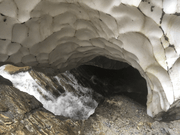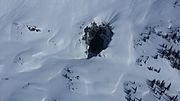Wells Gray Park Cave discovery facts for kids
Quick facts for kids Cave in Wells Gray Provincial Park |
|
|---|---|

An aerial view of the cave entrance.
|
|
| Location | Wells Gray Provincial Park |
| Depth | 500 m (1,600 ft) (est.) |
| Length | 2,100 m (6,900 ft) (est.) |
| Discovery | April 2018 |
| Geology | stripe karst |
| Entrances | 1 |
| Hazards | meltwater flow |
The Wells Gray Park Cave discovery happened in 2018. This amazing karst cave was found in Wells Gray Provincial Park, which is in the Cariboo Mountains of British Columbia, Canada. People have unofficially called it Sarlacc's Pit for now. It will get an official name later.
Contents
How the Cave Was Found
In the spring of 2018, a Canadian government team was flying a helicopter. They were counting caribou (a type of deer) to study them. The pilot, Ken Lancour, saw a very deep hole in the snow. This hole was the entrance to the cave!
The team decided to call the cave Sarlacc's Pit. This name comes from a huge creature called the Sarlacc. It lives in a pit in the movie Return of the Jedi. But remember, this name is just a nickname. The official name will be chosen after talking with the First Nations people who live in that area.
Exploring the Cave
In September 2018, a group of explorers went back to the cave. This team was led by geologist Catherine Hickson and surveyor John Pollack. The snow had melted, so they could go inside.
They went partly down into the cave. They guessed it was at least two kilometers (1.2 miles) long. The team plans to go back for more exploration. They want to learn even more about this huge cave.
Keeping the Cave Safe
The people who found the cave wanted to keep its exact location a secret. This was to protect the cave from damage. They didn't want too many visitors to harm this special place.
The Government of British Columbia also closed the area around the cave. This helps keep the cave safe. It also protects people who might try to explore it without proper gear.
Cave's Location and Type
News reports have said that Sarlacc's Pit is the biggest known stripe karst cave. A karst cave forms in rock that water can dissolve. Stripe karst means the rock layers are striped.
There are other deep or long stripe karst caves. For example, the Cascade Tupper System is 483 meters (1,585 feet) deep. The White Rabbit cave is 1 kilometer (0.6 miles) long.
Cave Entrance Size
Early guesses suggest that Sarlacc's Pit might have the biggest cave entrance in Canada. Its entrance is about 100 meters (330 feet) long. It is also about 60 meters (200 feet) wide. That's like a huge football field!
The entrance is at least 135 meters (443 feet) deep. A river flows into the entrance. It turns into a waterfall inside the cave. The mist from the waterfall makes it hard to measure the exact depth.
When to Explore the Cave
The cave is usually covered in snow for most of the year. It sits at the bottom of a huge avalanche slope. This means a lot of snow can slide down it.
Early fall might be the best time to explore the cave. This is when the waterfall inside has the least amount of water. In spring, a lot of melted snow flows into the cave. This makes it too dangerous to enter.
The cave might have been covered in snow all year until the 1900s. This means that First Nations people probably didn't explore it. Also, it takes special climbing gear to get down the deep entrance. So, it's unlikely that other mountaineers found it before.
Gallery



